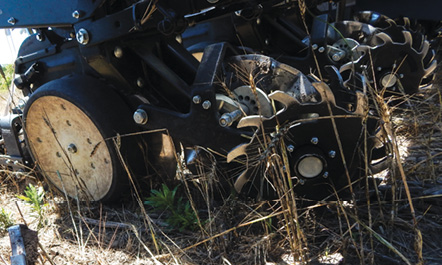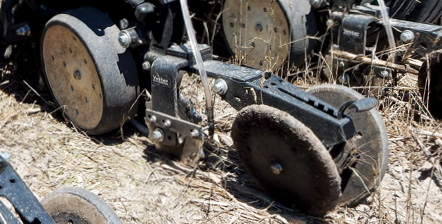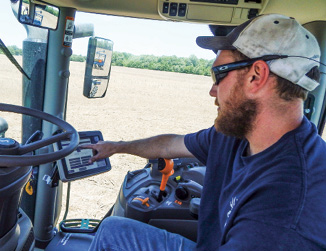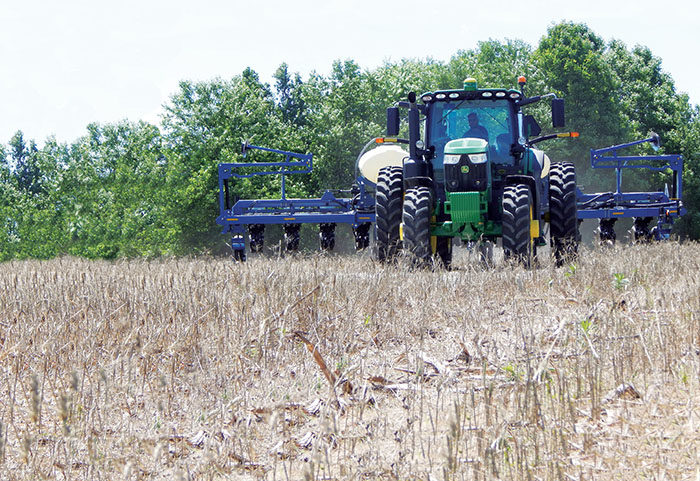Pictured Above: NATURALLY AERATED. Cory Atkins has been no-tilling lima beans for 3 years. He says lima beans thrive in an environment where the soil is heavily aerated, like conventional tillage. However, he believes he’s had success with them in no-till due to an increase in organic matter and a reduction in compaction, resulting in a natural aeration that keeps the soil loose around the lima bean’s roots.
Cory Atkins is a rare example of a young, first generation commercial farmer in an aging and family-centric industry. Although he grew up on a hobby farm with a roadside market and was tutored by an uncle who farms, he has taken it upon himself to obtain a production agriculture degree and expand the acres under his management.
With nearly a decade under his belt, the Seaford, Del., grower has acquired over 800 acres and recently took home the American Soybean Assn.’s 2016 Conservation Legacy Award for the Northeast U.S. region.
Characteristic of his lean beginnings, Atkins needed to expand his operation slowly and exercise precise judgement when making high-dollar purchases in either acreage or equipment. Being free from the constraints of family tradition, he was able to focus on the practices that were most cost effective rather than inheriting a strategy. These values are what lead him to his conservative and strict practice of no-tilling and cover cropping.
“When I started farming, I was using a lot of older equipment,” Atkins says. “I realized I was going to wear it all out by constantly discing everything. Neighbors told me not to no-till because the yield was going to drag, but here in Delaware there is so much dryland, it’s a beach. You can disc and disc all you like, but if it doesn’t rain, you’re not going to have a crop anyway.”
After seeing the potential savings in equipment wear and tear, fuel and manpower, he decided that yield would have to absolutely plummet in a no-till system in order to scare him away. After experimenting, he never encountered the alleged yield drag, making no-till all the more valuable to him.
“No-till is just so much more efficient for me,” Atkins says. “We’re growing around 275-300 bushels per acre of corn. When the neighbors are doing pretty much the same but they’ve been out there to disc it three times, no-till just seems like the best idea.”
Vegetable Experiments
Growing a variety of crops, Atkins planted about 300 acres of corn, 300 acres of soybeans, 100 acres of sorghum, 100 acres of lima beans, 30 acres of green beans, 30 acres of watermelons and 15 acres of squash this year. All of his crops, with the exception of watermelons and green beans, are no-tilled. Although expending most of his efforts on corn and soybeans, he experiments enthusiastically with his other crops in an attempt to find the most effective practices for his area.
“The added weed control I had with the residue has been excellent...”
No-tilling lima beans is one example. This practice was another idea that his neighbors warned against, but now in his third year of doing it Atkins has been mostly pleased with the results.
“The first year was awesome, but the second year wasn’t as great. I was helping a friend do it that year as well and he did just fine, so I think it was more weather-related because he got a bit more rain,” Atkins says.
“Lima beans want the soil to be aerated so cultivating them is good for that. They can double in size over a few days because they really like those conditions. That said, I think no-till has worked for me because the buildup of the organic matter and reduced compaction has helped keep soil loose around the root — sort of aerating it naturally.”

CUTTING THROUGH. This spring, Cory Atkins no-tilled lima beans into sorghum stubble that was harvested in fall 2015 and a winter wheat cover crop that had been terminated about 2 weeks prior. The Delaware grower tries to leave his cover crops growing as long as possible, as they can wrap in his row cleaners if they’re completely dry, whereas the no-till coulter can easily slice through covers that still have some moisture, he says.
The organic matter levels were as low as 1% in some of his sandier soils when he first took them under management. Since then, he’s been able to raise those levels from 2.5-3% in some areas.
Although yields have hovered around the same as with his previous methods, the weed control benefits he’s seen have made the change worthwhile. Planting them behind a wheat cover crop the first 2 years ensured that there was enough residue on the ground to choke weeds, which would have caused issues in previous years.
“You can moldboard plow, disc, chisel and row cultivate lima beans 2 or 3 times then spray herbicide over the top and still end up with weed issues,” Atkins says. “On top of that, there are only about two different herbicides you can use on lima beans to get rid of broadleaves. I still had to use a bit, but the added weed control I had with the residue has been excellent.”
He realized that he’d have to manage the amount of residue on the back end though — picking up leftover trash from sorghum or corn during harvest could get out of hand if he’s not careful. This is the same issue he faces with no-tilled green beans too, something he is trying for the first time this year.
“We’re just doing a single pass of no-tilled green beans as a trial,” he says. “With lima beans you’re shelling them so you’re eating the bean instead of the pod, but when we harvest the green beans it’s the whole bean. If you’re getting leftover corn stalks in there and the harvester can’t get them back out, it’s a problem. Although I’m worried about the residue, the beans themselves are coming up strong and they look healthy.”
Early trials with no-tilled squash are also starting to look promising this year as well. He grew squash on a larger scale for the first time last year due to a special order, but he quickly found that the conventional methods created a lot of hassle.
“Last year we were in a hurry so we disced twice and planted,” Atkins says. “With vegetable crops, working up the ground is necessary because their root systems tend not to be vigorous. We hooked up drip tape irrigation on them and ended up with a good crop, but the weeds were terrible.”
Squash, being another crop that doesn’t have a lot of effective herbicide solutions available, can call for a fair amount of hoeing and cultivation to control weed pressure.
“I felt like hoeing was 1950s technology,” he says. “I had to hire some high school kids to do it on really hot days in the middle of August. It was difficult.”
This year he devoted even more acres to squash, but decided to no-till them in hopes of saving money on weed control.
“If I could mulch between the rows with residue, I’d have less weeds,” Atkins says. “They are coming up fine right now, but we may not get as big a yield. As long as it’s relatively close to what I got last year though, I’ll be fine.”
He adds that a cousin of his had some squash this year that he had already disced and sprayed with Gramoxone as a pre-emergent to clean up morning glories. But he still has to get back in and cultivate and hoe.
“I am that far ahead of him already,” Atkins says. “You have to pay at least $10 per hour to get someone to hoe it, and it takes a while. We’ll see what happens on the yield end to determine which method is more effective.”
Starting with Covers
Like no-tilling, cover cropping seemed an obvious choice to Atkins from the start as he expanded his operation. Although he’s the first to admit that penciling out the exact return on investment is tricky, the benefits are too many for him to ignore.

COULTER TRADE OFF. Purchased this year, Cory Atkins’ new 12-row Kinze 3660 planter is equipped with Yetter fertilizer coulters mounted on the back. He’s noticed that the coulters sometimes dampen soil to the point that it sticks to the closing wheels. But he feels it’s better than having them up front because a rear fertilizer coulter makes it easier to access the row cleaners in case they need servicing, and they take less of a beating, making them cheaper to maintain.
“It’s cheap. If you take $4 wheat and spread it 2 bushels to the acre, it’ll only be $8 per acre,” he explains. “It’s hard to quantify the return but I just feel, on principle, that you always want to have something growing on the farm to be building up that root mass and controlling weeds. Roundup costs $4 an acre too, and even more if you have to hire someone to spray it.”
Such is Atkins’ belief in cover crops that he was using them even before he was aware of the state subsidy. Delaware offers farmers $50 per acre if cover crops are planted by the end of September and $40 per acre if planted by the end of October, up to a cap of $10,000. This works well for Atkins because he believes in planting them as soon as possible.
“If I can swing it, I like to seed three passes behind the combine,” he says. “We’ll broadcast and then lightly vertical till with a McFarlane Mfg. Reel Disk, but only if there is too much residue and we need the extra incorporation. Like in sorghum stalks, there won’t be enough seed-to-soil contact unless you chop it up a bit.”
On the other end, the state stipulates that the cover crops need to be sprayed by June 1 to qualify for the subsidy. Depending on what he’s planting and field conditions, Atkins leaves the cover crops green for as long as possible.
“If the cover crops still have some moisture, the no-till coulters cut through them easily…”
“If cover crops are green and growing, they are sucking up rainwater,” he says. “From a mulch and weed standpoint you’re really not getting the same benefit either, because if you kill it too early, the ground will be bare by the time you’re planting. A lot of green stuff plants better too. It’ll break where old dead stuff wants to hairpin. If it still has some moisture, the no-till coulters cut through it easily.”
Although he has tried crimson clover, radishes and rapeseed, his favorites are wheat, barley and rye.
“Sometimes clover can be hard to plant and kill,” he says. “It doesn’t always die off completely and if it’s damp when we are trying to plant corn, it wants to wrap all around the row cleaners like a spider web.
“I’m not a fan of radishes because they winterkill and there’s just nothing there in the spring. Plus, they get too big and you no-till into them as they rot, you’ll get air pockets that might reduce seed to soil contact. It’s like planting over a fox hole.”
Atkins says that he uses mostly winter wheat and cereal rye. He tries to plant rye in fields that are going into soybeans the next season and wheat where it will go into corn. Although he does worry about air pockets, he has found radishes to be useful on heavier soils and in areas where he can get them planted and established early.
Rate Adjustments
Other variables Atkins enjoys tweaking are his input rates and methods. From adjusting the population to sprayer droplet size, guessing and checking to reach greater efficiency is a perpetual interest of his.
“I like to play with different pressures on the sprayer across the field,” he says. “When you’re running more pressure you have to watch the wind, but getting the particles finer so you get good coverage on the plant is the difference between dropping a quarter or a handful of rice on the ground.”

POPULATION CONTROL. With a hydraulic drive on his new planter, Cory Atkins can easily adjust seed population from inside the cab while he is on the go. He feels this will help him find a “sweet spot” that balances yield and seed costs. This year he planted a 65-acre field of soybeans with populations varying from 60,000-130,000 to see how they’ll impact yields. He thinks he’ll discover he’s been planting too high.
Atkins tries to run as much of his fertilizer through his planter as possible and then applies the remainder via spray or broadcast.
“We’re running about 30 pounds of 28% liquid nitrogen (N) 2 inches away from the seedbed,” he says. “Then we’ll come back about 4-6 weeks later, depending on the crop, and broadcast ammonium sulfate and urea over top. We’re coating the urea with NutriSphere-N and Agrotain to help with volatility and leaching.
“When corn gets about waist high, I can still get in there with my sprayer and dribble N, so at that point we’ll have a little over 100 pounds of N on dryland corn and we’ll add another 10-30 pounds.”
Potash and lime are also variable-rated depending on annual grid sampling results pulled from every 2 acres. Potash rates usually end up around 200-300 pounds per acre.
Since buying his 12-row Kinze 3660 planter earlier this year, he has been pleased with the ability to perform population tests more easily.
“With the hydraulic drive I can change seed population right from the cab,” Atkins says. “Swapping out sprockets on a mechanical drive is a greasy mess; now I can just press a button.”
He likes to test things out with his soybean crop first. He typically runs a population of 120,000 or 100,000, but he thinks he’ll discover that he’s been planting too high. He feels being able to run tests so easily will help him find a sweet spot that balances input costs with yield. He looks forward to harvesting a 65-acre field that has test rates of 60,000, 80,000, 100,000, 120,000 and 130,000.
“I think there is money to be saved here. There are still some guys in my area planting sorghum at 90,000 and that’s around 30,000 over,” he says. “They say they got 150 bushels last year and that’s what I got planting at 60,000. Of course, sorghum seed is cheap, but why spend the money if you don’t need it?”





Post a comment
Report Abusive Comment